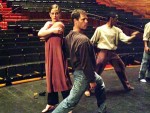Title
Thirty-nine bodies are in motion in a Juilliard dance studio, threatening to burst its confines. They are informally testing out, shaping and committing to muscle memory an intriguingly eclectic array of disparate phrases. Two dancers, standing side by side, zip through a revved-up sequence as though they were on fast-forward. Others, alone or in pairs or trios, go through sequences that range from the slippery to the sensual to the precise.
Body
This is the scene just before a rehearsal of Ohad Naharin’s From Max and Three officially begins. The acclaimed, always surprising Israeli choreographer—a Juilliard alumnus and the longtime artistic director of the Batsheva Dance Company—agreed to create a new dance for Juilliard’s spring performances, drawing on and adapting elements of his two most recent full-company works. Arriving at Juilliard in early February and presented with the 39 Dance Division students who were not committed to the program’s other works (see sidebar), Naharin decided to work with all of them.
No one today can fill a stage with more surprising and luscious movement than Naharin. His choreography veers in odd and unexpected directions, yet everything the dancers do looks inevitable and organic. His specific movement technique, which evolved over the years and is what his company classes consist of, is called Gaga and has led him to a newly open and exploratory approach in his choreography.
“Dancers love to do his movement. It’s very visceral, sensual work. It’s very deep in the body—things which dancers today seem to find very interesting,” says Lawrence Rhodes, director of Juilliard’s Dance Division. He has admired Naharin’s work since he first encountered it during the 1980s, and first commissioned a piece from him for New York University students in 1986. He introduced dances by Naharin to the repertory of Les Grands Ballets Canadiens during his tenure as artistic director there, and has previously programmed his choreography at Juilliard.
When Naharin arrived in early February for an intensive week at Juilliard, he and Rhodes had already decided that he would incorporate and adapt sections of Three (2005) and Max (2007). (Batsheva is performing the latter work at the Brooklyn Academy of Music, March 4-7.) But his time with the students would determine what portions would be included and how they would be combined. Naharin’s obligations to Batsheva, which was then on tour in the U.S. and committed to a rehearsal period for his next major new work, limited his availability. Before he returned to Juilliard for final rehearsals, his longtime associate, Yoshifumi Inao, led the daily rehearsals and also taught some Gaga classes.
During a phone interview from Tel Aviv (where Batsheva is based) a few weeks after his week with the students, Naharin, 56, spoke—always thoughtfully, sometime cryptically—about this Juilliard project, and his time in the studio with the dancers. “It’s a lot about the ability to give people keys to open something they have in themselves. This gesture of giving someone the key has a lot to do with the people’s desire to receive it. So my task is to create an atmosphere where people are willing to receive those keys. It’s not so much that I need to ‘teach’ them as much as to remind them to use their own treasures.”
Naharin says that Gaga “is not a style—it’s an information about texture, efficiency, explosive power. It gets people in touch with their movement habits. It is a lot about sensation and a lot about alertness—about really listening to what’s going on inside your body. But the relationship with space is really one of the most important things, because the movement has to do with organizing ourselves in space. Gaga teaches a lot about efficiency of movement, an instinctual and animal kind of quality—and still without losing your idea of line and technique. Through Gaga, you can not only maintain your strength but actually go further, and go beyond familiar limits.”
At Juilliard, he taught Gaga to the senior class, and in rehearsal immediately gave the dancers a great deal of responsibility. He worked with them on an extended sequence taken from the last section of Three, in which dancers from three lines come forward, launch into a brief phrase, and return to the back of the line to await their next “turn.” As they rehearse this passage under Inao’s watchful gaze, some phrases seem to be absorbed from one dancer to the next, while others are completely unique. Some are extended contortions, others have the force of a sharp exclamation point. Each dancer makes a strongly individual mark, then matter-of-factly retreats upstage.
“Everything that you saw [in rehearsal] is their own material. It wasn’t taught to them. It was something that was created during the four days I was there,” Naharin explained. He presented them with the format and the music from Three, “but the choices of movement that each dancer does, came out of their own composition—except for some few gestures that I’ve done for them. Most of the individual material is their own. I just gave them some tools and a framework. But they immediately had the responsibility of phrasing, remembering and connecting to the information that I provided.”
Naharin also created a new transitional section for the full ensemble, specifically for this Juilliard work. “I decided about this transition as I was observing the dancers. So I made up something small—but I think it’s important.
“I’m enjoying being able to give these people at the beginning of their careers everything that I can in a short time. There is a definite learning experience for me. A lot of what I do involves the ability to communicate to dancers. Every time I meet dancers with whom I haven’t worked before, and for a short period, it teaches me a lot about that communication—about being efficient and articulate and supportive, positive, and still demanding.”





